new posts in all blogs
Viewing: Blog Posts Tagged with: graphic novel, Most Recent at Top [Help]
Results 1 - 25 of 642
How to use this Page
You are viewing the most recent posts tagged with the words: graphic novel in the JacketFlap blog reader. What is a tag? Think of a tag as a keyword or category label. Tags can both help you find posts on JacketFlap.com as well as provide an easy way for you to "remember" and classify posts for later recall. Try adding a tag yourself by clicking "Add a tag" below a post's header. Scroll down through the list of Recent Posts in the left column and click on a post title that sounds interesting. You can view all posts from a specific blog by clicking the Blog name in the right column, or you can click a 'More Posts from this Blog' link in any individual post.
The Great Antonio is Elise Gravel's loving tribute to Antonio Barichievich, the Croatian born strong man who was a Montreal fixture for many years. The Great Antonio is also yet another superb beginning reader from the fantastic TOON Books. Gravel begins this fanciful story of the life of this giant of a man speculating about his possible parentage and wondering about his childhood in Croatia. This may seem like an odd subject for a beginning reader, but Gravel tells Antonio's story with a playful tone that is immediately engaging.
To show readers just how HUGE Antonio was, she shows his clothes (a cat could sleep in his shoe, but it was quite smelly) and his eating habits. She also shows reader the various opponents he wrestled and the many enormous, heaving things he lifted and pulled.
Antonio was larger than life and stories about him border on the unbelievable. Reading Gravel's author notes at the end of the book helped me get a perspective on this strange - for a beginning reader, anyway - story. Gravel shares that one of her favorite authors is Roald Dahl, who "got her interested in unusual people and animals," saying that she is, "attracted to anyone who is STRANGE or FUNNY." Growing up in Montreal, Gravel was very familiar with this strange and funny man. Like Sampson, Antonio had magnificent hair - long, thick dreadlocks that fell to the ground and were often used to pull buses. Or, Antonio would put metal in his braids and use them as golf clubs and more.

Gravel gives The Great Antonio the feel of a tall tale, speculating about his life and his feats but also respectfully sharing the stranger aspects of it. Near the end of his life, Antonio chose to live on the streets of Montreal, using a donut shop as his office. Gravel tells readers that, when he died, a mountain of flowers was left at his favorite table at the donut shop. Antonio himself may have created this air of mystery about himself, lending to his larger than life persona. In her author notes, Gravel shares that, after his death, many of his "wild stories" were proven to be true!
Source: Review Copy
 Jeffrey Brown is the author of the first three fantastic Jedi Academy books, as well as many other hilarious books in which Darth Vader copes with hand-son fatherhood. Now, following another passion of his, he has created a graphic novel series Lucy & Andy Neanderthal, featuring siblings, Lucy and Andy, their clan, and some prehistoric creatures.
Jeffrey Brown is the author of the first three fantastic Jedi Academy books, as well as many other hilarious books in which Darth Vader copes with hand-son fatherhood. Now, following another passion of his, he has created a graphic novel series Lucy & Andy Neanderthal, featuring siblings, Lucy and Andy, their clan, and some prehistoric creatures.
 If you have read any of Brown's other books, then you know he is fantastic when it comes to creating engaging characters. Although I came of age with it, I'm not a fan of Star Wars, yet I found Brown's Jedi Academy books completely enthralling precisely because of the characters he populated this world with. In Lucy & Andy Neanderthal, we meet the tween siblings, their parents, Mr. and Mrs. Luba, and their baby brother Danny. Margaret and Phil, teens who are part of the clan, and the creaky old Mr. Daryl. As the older sister, Lucy can seem like a know-it-all, at least to Andy. In a funny twist, Brown gives Lucy some insights beyond her era, causing the other kids to think she's weird.
If you have read any of Brown's other books, then you know he is fantastic when it comes to creating engaging characters. Although I came of age with it, I'm not a fan of Star Wars, yet I found Brown's Jedi Academy books completely enthralling precisely because of the characters he populated this world with. In Lucy & Andy Neanderthal, we meet the tween siblings, their parents, Mr. and Mrs. Luba, and their baby brother Danny. Margaret and Phil, teens who are part of the clan, and the creaky old Mr. Daryl. As the older sister, Lucy can seem like a know-it-all, at least to Andy. In a funny twist, Brown gives Lucy some insights beyond her era, causing the other kids to think she's weird.
Brown includes two anthropologists, Pam and Eric, in Lucy & Andy Neanderthal. The scientists occasionally appear to share facts about life 40,000 years ago in the Stone Age as well as to let readers know when aspects of Brown's book might not be scientifically accurate, starting with Tiny, Lucy and Andy's pet cat. One thing I really love about the information that Pam and Eric share are the illustrations that accompany them. Brown shows readers what actual anthropologists might see when they are at a dig site, impressing upon readers that what we know scientifically comes from finding the remains of these early humans and their civilization, something somewhat abstract that could elude them.

In this first book in the series, readers see Lucy and Andy and their clan as they hunt a wooly mammoth, with the violence of the kill off the page. We see Lucy creating some cave art on a rainy day with some very funny hijinks and critiques from the adults of the clan. In another chapter Andy's toothache ends with an explanation from Pam and Eric on Neanderthal health care, of the lack thereof. Finding the remains of a wooly mammoth leads to a chapter on Neanderthal clothing and how it was made, which is important as winter approaches. As Lucy & Andy Neanderthal draws to a close, the clan encounters another group of people who seem a bit more civilized. I can't wait to see what happens in the next book as winter sets in!
Source: Purchased
Snow White has always been Matt Phelan's favorite fairy tale. Phelan got the idea to set his version of Snow White in Depression Era New York City while sketching apple peddlers for a story he wrote about Herbert Hoover for the anthology book Our White House. Phelan's illustration lends itself marvelously to the noir tone of this story that is set amidst the end of the Jazz Age and the beginning of the Depression. With the Queen of the Zigfield Follies cast as the wicked stepmother and Detective Prince taking on the role of Charming, the casting is perfect - especially Snow White's protectors and friends, the Seven Dwarves. 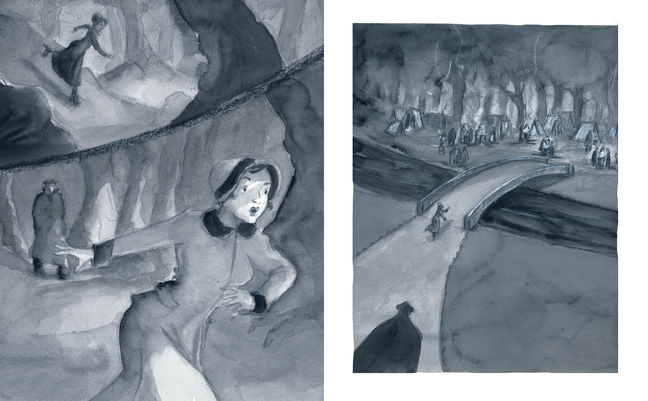
Samantha "Snow" White lost her mother to tuberculosis when she was a little girl. Her father remarries and she is sent to boarding school. Snow's father is a business man and his ticker tape machine, one that he watches with growing unease and concern, especially after surviving the crash. Phelan brilliantly has the ticker tape stand in for the magic mirror that drives the Queen to her wicked deeds. After Snow's father dies, it is his will, naming her as the sole inheritor, not her potential as a rival beauty, that causes her exile. This exile granted to her, instead of death, by Mr. Hunt, a goon with a heart of gold.
 Snow flees to Hooverville where she is rescued by a gang of orphaned boys living on the street. Their relationship is one of my favorite parts of Snow White, with the tough urchins refusing to tell Snow their names, until a tender, heartbrreaking moment later in the tale. I don't want to give away all of Phelan's marvelous adaptations, but I will say that the store window of Macy's does play a special role in this story. Phelan's expressive, suggestive illustrations save the sharp lines for the wicked stepmother's Louise Brook's bob, glaring eyes and her fitting end. Snow and the boys are soft lines and smiles when the world is treating them well, and the ending to Snow White treats them very well and just might bring a tear to your eye. Phelan uses splashes of red sparingly, eloquently and effectively in Snow White, with most of the story playing out in slate greys and occasional icy blues. However, Phelan's "happily ever after" is presented in a warm palette that is indeed a happy ending.
Snow flees to Hooverville where she is rescued by a gang of orphaned boys living on the street. Their relationship is one of my favorite parts of Snow White, with the tough urchins refusing to tell Snow their names, until a tender, heartbrreaking moment later in the tale. I don't want to give away all of Phelan's marvelous adaptations, but I will say that the store window of Macy's does play a special role in this story. Phelan's expressive, suggestive illustrations save the sharp lines for the wicked stepmother's Louise Brook's bob, glaring eyes and her fitting end. Snow and the boys are soft lines and smiles when the world is treating them well, and the ending to Snow White treats them very well and just might bring a tear to your eye. Phelan uses splashes of red sparingly, eloquently and effectively in Snow White, with most of the story playing out in slate greys and occasional icy blues. However, Phelan's "happily ever after" is presented in a warm palette that is indeed a happy ending.
Read my reviews of more of Matt Phelan's graphic novels and picture books here
Source: Review Copy
By
Cynthia Leitich Smithfor
CynsationsCheck out the book trailer for
Snow White by
Matt Phelan (Candlewick, 2016). From the promotional copy:
Award-winning graphic novelist Matt Phelan delivers a darkly stylized noir Snow White set against the backdrop of Depression-era Manhattan.
The scene: New York City. The dazzling lights cast shadows that grow ever darker as the glitzy prosperity of the Roaring Twenties screeches to a halt.
Enter a cast of familiar characters: a young girl, Samantha White, returning after being sent away by her cruel stepmother, the Queen of the Follies, years earlier; her father, the King of Wall Street, who survives the stock market crash only to suffer a strange and sudden death; seven street urchins, brave protectors for a girl as pure as snow; and a mysterious stock ticker that holds the stepmother in its thrall, churning out ticker tape imprinted with the wicked words “Another . . . More Beautiful . . . KILL.”
In a moody, cinematic new telling of a beloved fairy tale, extraordinary graphic novelist Matt Phelan captures the essence of classic film noir on the page—and draws a striking distinction between good and evil. See also
Interview: Matt Phelan on Snow White: A Graphic Novel from Teenreads.com. Peek: "It’s the goodness of Snow and her optimism that conquers the evil. It’s an important thing to remember in today’s world."
This summer, I discovered that Alexis Deacon, picture book illustrator, author and frequent collaborator with another favorite of mine, Viviane Schwarz, had created Geis, a graphic novel that was already on sale in the UK. I waited patiently for it to go on sale here and, when I finally got to read Geis, I was surprised, enthralled and left breathless by the beauty of the illustrations, the rich world building and the fast pace of the story. I was so sad to read the end of Geis, but, I realized half way into it that it is a trilogy, so there is more to come!

Geis begins with a definition of the word "geis," pronounced "gesh," which is a Gaelic word for a taboo or curse, "like a spell that cannot be broken and certain rules must be obeyed." In an unnamed world that is reminiscent of a Bruegel painting, the Great Chief Matarka is dying without leaving an heir. Fifty people, including the Grand Wizard, the High Priest, the Chief Judge and the Lord Chamberlain have been called to her death bed. Among them is Io, the young daughter of the Kite Lord. Matarka has devised a contest that will determine who will take her place, but Niope, an evil sorceress, using Death Magic, has taken control of the event and tricked the fifty attendees into signing their names to a cursed parchment.


The fifty attendees are hurtled to various corners of the realm by the sorceress and must return to the death chamber to prove their worthiness. Io is the first to return where she learns the horrible truth of the geis from the sorceress. Nemas is next and together, the two know the truth of the challenge the fifty souls face but are not allowed to speak of it. When they do, the curse renders them speechless. They learn that they have until the next sunrise to leave the castle and return for a challenge that will leave all but one of them dead. As Io and Nemas prepare for this battle, we see others facing their fates, some of which are horrific, with bravery and cowardice, together and alone.

Geis is over almost as soon as it starts, yet you reach the final page of this graphic novel feeling like you have been gone for much longer. This is in large part due to Deacon's amazing illustrations and masterful world building. I was reminded immediately of the work of Maurice Sendak, some of which I have shared below. Io proves to be a young but brave and moral hero, struggling to survive in a world that no longer makes sense. I can't wait to see how she faces her next challenge!
Source: Purchased

Jeffrey Brown authored the first three books in the Jedi Academy series, two of which I enthusiastically reviewed here. This trilogy is HUGELY popular in my school library and a fantastic alternative to Diary of a Wimpy Kid. Before that, Brown wrote a trilogy of Darth Vader, a comics series that imagines Vader's life as father to Luke and Leia. Brown's new series debuted in August and features prehistoric siblings Lucy and Andy as they deal with typical kid stuff while also being filled with scientific information and facts about pre-history.
Jedi Academy was too good to let go, and quite smartly, Scholastic has tapped Jarrett Krosoczka, author of the Lunch Lady series of graphic novels. Jedi Academy: A New Class finds young Victor Starspeeder making a midyear transfer from the Jedi Academy at Obroa-skai, where he has had a series of mishaps to the Jedi Academy at Coruscant. Victor decides that he is going to start keeping a journal of his time at Jedi Academy because that is what his father, who died when Victor was a baby, did. 
The Jedi Academy has its own challenges, starting with Christina, Victor's big sister, who already goes there. She tells him in no uncertain terms that once they are at school, they are strangers. Navigating the new school on his own, Victor is swayed by Zach, and older student, who turns out to be a bully and a prankster with his own agenda. He also gets stuck with Artemis, an asthmatic kid in a black hooded cloak who just might be a Sith. Victor tries to make friends, impress a girl, and get his special project on the planet Endor completed while also trying to stay out of trouble and keep Zach from getting him kicked out.

Krosoczka hits all the right notes in Jedi Academy: A New Class, continuing and updating features that Brown introduced in the first three books like handwritten notes between characters, school schedules and pages from the school newspaper, including an advice column by Ms. Catara, the school guidance counselor who is also a Gungan. Krosoczka also creates a couple new twists, including the Galaxy Feed, which is a social media type feature that pops up on a tablet like device, and a page of comic strips that look at classics like Family Circus, Peanuts and Garfield through the lens of Star Wars. I especially liked, "Huttfield," in which Jaba the Hutt is the lazy, food loving star of the strip.
While I love that this series continues on (and I hope that, after another three books a new author/illustrator takes on this challenge) and am thrilled that I have more of these books to offer students, for me, Krosoczka's take on the academic world of the young Jedi lacks a bit of the depth, heart and humor that I found in Brown's books. But hey, I'm pretty sure I'm not the target audience for these books...
Source: Purchased
Ape and Armadillo Take Over the World by James Sturm is my new favorite book. I fell in love with TOON Books when I discovered them in 2008, just around the time my youngest was learning to read. Having been through this process with my two older children, I was not looking forward to the tired old leveled readers that we were left to slog through after classics like Frog & Toad, Little Bear and Poppleton. Françoise Mouly and her quest to bring engaging, marvelously illustrated graphic novels into the world of beginning readers has meant that there are now over 50 fantastic books to take your new reader from sight words to chapter books.

If you have read even a few beginning readers, you know that unlikely friends and the complexities of friendship are the staple of this genre. With Ape and Armadillo, Sturm has created the only duo who could even remotely rival Frog and Toad. And an armadillo! How many armadillo characters are there in kid's books to begin with? Happily, the title page shows Ape juggling, a curled up Armadillo among the balls in the air. Sturm's illustrations are superb - crisp and colorful and filled with motion and emotion.

Armadillo is a little guy with big ideas. Ape, his opposite, is more thoughtful and compassionate. When Ape and Armadillo Take Over the World begins, we find Ape taking issue with Armadillo's plan for world domination. While Armadillo does things fly away on the royal Pegasus, Ape has to distract a spitting serpent, fight an army of robots and escape through the sewer tunnels of the castle. Armadillo counters, saying that he is the one who thought up this plan and having ideas is not so easy. When Ape tries to come up with a plan (that involves kids, an ice cream shop, juggling Armadillo and hiding in tubs of ice cream) Armadillo shoots him down. But, like all good friends, the two manage to find common ground, coming up with a phenomenal plan for world domination that involves special suits, magic wands, creating a zoo filled only with really cool animals like griffins, dinosaurs and giant bugs and ending with ice cream. Because, as Ape points out, he likes a lot of the people in the world and doesn't want to rule it or blow it up.

The best part of Ape and Armadillo Take Over the World? Sturm includes bonus comic strips that run at the bottom of every page, giving readers a glimpse into the personalities of the main characters. Ape and Armadillo embody the creative imagination of kids, a creativity that is not bound by logic or physical limitations.
Read my reviews of the Adventures in Cartooning Series here
I don't think I can put into words how much I love The Creepy Case Files of Margo Maloo by Drew Weing. Not only is Margo just about the coolest girl detective I have encountered in quite a while, she is kind of a ghostbuster. More accurately, Margo Maloo keeps the peace between the world of the humans and the hidden world of monsters in Echo City. Best of all, The Creepy Case Files of Margo Maloo started as a web comic and continues on line where you can read new chapters! The Creepy Case Files of Margo Maloo begins with Charles Thompson's move from a small town to the big city, a move he's not happy about. The Thompsons are moving into the Bellwether, a former hotel built in 1925 with authentic Art Deco fixtures. Along with a few other residents, they will get to live there for free while Charles's dad fixes the place up. Charles, not much of an outdoors kind of kid, fancies himself a budding journalist and writes a blog.
Charles meets Kevin, a neighbor who is trying to break a world record, any world record. Kevin tells Charles like where the best candy store in the neighborhood is and what to do if anything weird is going on in your apartment. It just so happens that, the night before, a huge monster crept out of the closet after Charles turned off the lights. Kevin hands him the business card of Margo Maloo, monster mediator, and the adventure begins.

Drew Weing brings a fantastic sense of humor, a marvelous eye for detail and a brilliant talent for world building to The Creepy Case Files of Margo Maloo. She and Charles head to the lair of a local troll named Marcus who collects Battlebeanz, specifically the Big Cat set. In one of Weing's superb details, he creates names for many of the Big Cats like "Dread-Lion," "Fight-Mare" and "Ty-Gore," and Marcus and Charles have a fast paced conversation about them. Another great scene comes at Ms. Koff's store, a grocery store for monsters hidden under a Quickmart. Weing's illustrations for these scenes are dark and creepy and filled with things you will pore over again and again.

Once he gets over his initial fear, Charles is hooked and wants to tag along with Margo, even suggesting he become her partner after he helps her find a missing ogre baby with a serious sweet tooth (yet another chapter with great twists, this one involving a kidnapper who wears a baseball cap and takes notes all the time but is not Charles...) In the end, Charles settles for assistant when Margo tells him he knows too much. She either has to put him to good use of have him "' accidentally' run into a pack of hungry ghouls."
Best of all, Weing's layered story ends with a few pages from an encyclopedia of monsters with Margo's notes in the margins! Which reminds me, another super cool think about The Creepy Case Files of Margo Maloo is the trim size of the book, which is exactly like a slightly oversized reporter's notebook! I can't wait for the next installment of creepy case files!
Source: Review Copy
Five years ago I reviewed my first book by Ben Hatke and I was immediately hooked. You can read my reviews of all of his books here. After a couple of picture books and a mostly wordless graphic novel, I am very excited to be reviewing the first in a new trilogy, Mighty Jack, a play on the old fairy tale with a garden full of enormous plants and some serious sword play. And, as always, you can expect strong girl characters who share equal page time with the titular Jack.
Hatke is a gifted visual story teller and Mighty Jack is driven by the illustrations with spare but meaningful dialogue, including lots of great onomatopoetic expressions. He begins the his story with Jack being awakened from a dream. His mother is out the door, on the way to the flea market. Past due bills can be seen on the counter as Jack grabs breakfast to go. In the car, she explains that she is going to work two jobs this summer and will need Jack to help more with Maddy, his younger sister who is on the spectrum. At the flea market (where fans of Hatke's will spot characters from past graphic novels), Jack's mother gives him money to buy food and the keys to the car in case Maddy needs to get away from the crowds. But when the non-verbal Maddy speaks, emphatically telling Jack that he has to make a deal with the suspiciously friendly man sitting behind a table with a sign that says, "Just Stuff," Jack makes a deal - his mom's car for an ornate wooden box filled with packets of seeds.


Maddy is up and early the next day, planting a garden. Jack helps, happy to see her busily at work, but also apprehensive. What grows from the seeds is both amazing and frightening and Jack is not sure how to handle it, especially since Maddy is so attached to the garden. Happily, a homeschooled neighbor who is also a fencer, stops by. Lilly is soon helping Jack and Maddy while also pocketing seeds and cuttings as she goes. Hatke's marvelous imagination blooms in Maddy's garden, from adorable little onion-headed babies to menacing melons with vine-y legs. The presence of Wormweed, eradicated from earth for thousands of years, even calls forth a dragon from another realm. Jack, Maddy and Lilly even begin to sample the fruits of the garden, reveling in the magical powers each plant gives them. Eventually, though, Maddy is injured and Jack discovers a plant that drives him to destroy the garden.
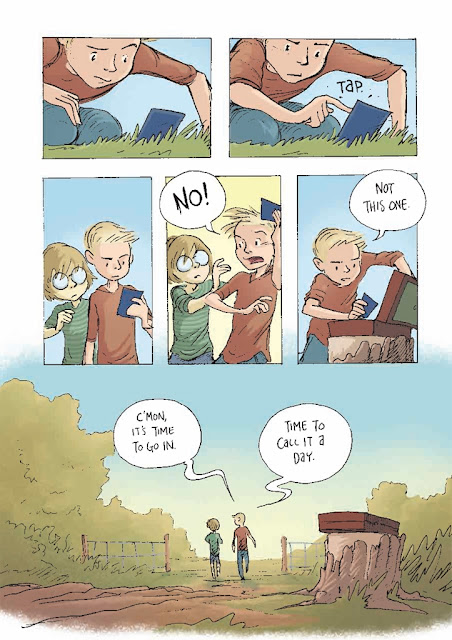
Thinking that the adventure is over, Jack discovers that both Maddy and Lilly have been keeping secrets and a new adventure begins. This time, though, Jack is well equipped with fencing gear and an equally brave and strong partner at his side.
Ben Hatke, fencing!
Source: Review Copy

In 2010, Raina Telgemeier was my introduction to graphic novels. As a bookseller, I was aware of the section with graphic novels for adults and, for the most part they seemed like bleak, dark stories filled with superheroes. Upon seeing Telgemeier's book on the shelf in the kid's section, I was drawn to the mint green cover with the bright yellow, braces filled smiley face of Smile. While I was a bit suspicious, thinking this might be a more superficial story about the awkwardness of braces, I was hooked immediately when I read the first few pages, learning real, autobiographical story behind the braces. Since that day, I have eagerly awaited, read and reviewed all of Telgemeier's books (except Sisters, for some reason) and you can read those reviews here. When I became an elementary school librarian two years ago, one of my first missions was to create a graphic novel section. The shelves currently hold (when they are not checked out, which they always are) ten copies of Smile and Sisters, three copies of Drama and four sets of the four The Babysitter's Club graphic novels, including one set in the newly colored editions. And, once I get my book budget for the year, there will be five library bound copies of Ghosts sitting beside the three paperback copies I bought out of pocket.
Raina Telgemeier has a gift for creating immediately accessible characters who are as colorful and full of life as her vivid illustrations. She also is exceptionally talented at presenting families that, while they have their struggles and conflicts, are connected, supportive, loving and thoughtful. With Ghosts, Telgemeier adds a new layer to her storytelling in the character of Maya, younger sister of main Catrina, who suffers from the degenerative condition, cystic fibrosis. Maya's illness is what causes the family to move from Southern California to the small seaside town in Northern California, Bahía de la Luna. As a native Californian, I love that Telgemeier sets some of her stories here and was so excited to learn that the town of Half Moon Bay was the inspiration for the setting of Ghosts. I also got a kick out of her version of In & Out Burger, a chain restaurant that is only in Southern California.
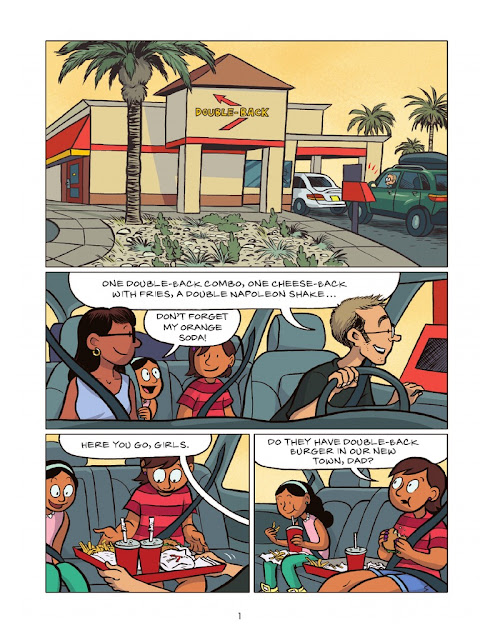
Telgemeier introduces and balances many themes skillfully in Ghosts. There are sibling issues, like Maya's illness and how Cat lovingly protects her but also wants a life of her own, separate from Maya. Then there are family issues that arise as they settle into Bahía de la Luna, which has a large Mexican American population. When the girls learn about Día de los Muertos, the Day of the Dead, which is celebrated with a huge festival and midnight party in Bahía de la Luna, Maya questions her mother about her childhood as a second generation Mexican American. And, with Ghosts, Telgemeier introduces magical realism into her story telling. Carlos Calaveras, neighbor and classmate of Cat's, works as a guide, giving tours of the ghosts of Bahía de la Luna. Cat is suspicious, then furious after she sees that Maya is enthralled with the idea of ghosts and take chances with her health to see one.
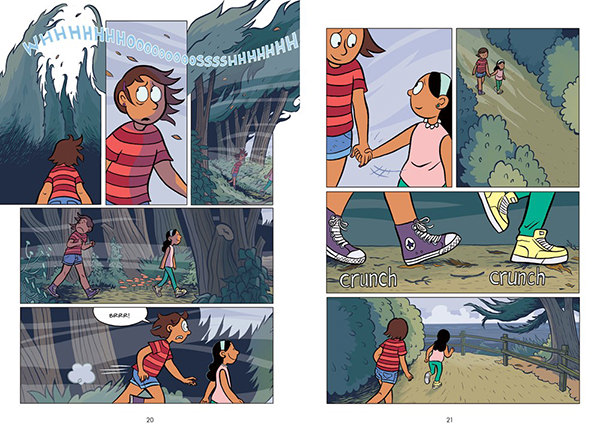
 Cat tries to humor Maya and her excitement over meeting a ghost, but their expedition ultimately puts her in the hospital. Cat spends the rest of the novel coping with her guilt, making new friends, being angry at Carlos and worrying about Maya. Telgemeier ends Ghosts with the marvelous Halloween night, which flows into to the Día de los Muertos celebration where Cat has a change of heart that allows her to make connections with the abuela she never knew, forgive Carlos and make Maya's wish come true.
Cat tries to humor Maya and her excitement over meeting a ghost, but their expedition ultimately puts her in the hospital. Cat spends the rest of the novel coping with her guilt, making new friends, being angry at Carlos and worrying about Maya. Telgemeier ends Ghosts with the marvelous Halloween night, which flows into to the Día de los Muertos celebration where Cat has a change of heart that allows her to make connections with the abuela she never knew, forgive Carlos and make Maya's wish come true.
This is a fantastic trailer that captures the magic of Ghosts!
Raina Telgemeier's books:
 Eric Orchard is the creator of Maddy Kettle, Book 1: The Adventure of the Thimblewitch in which eleven-year-old Maddy heads off on a quest after her bookstore-owning parents are turned into kangaroo rats by spider goblins. In Bera the One-Headed Troll, tables are turned as Bera, a troll, finds herself with a human infant she is trying to return to its parents. Bera's spare world is one of nighttime - if sunlight touches her, she will turn to stone - rendered in faded oranges and browns. And it is filled with ghosts, ogres with more than one head, benevolent rats, evil mermaids and hedgehog wizards that are a little creepy, a little goofy and entirely fascinating.
Eric Orchard is the creator of Maddy Kettle, Book 1: The Adventure of the Thimblewitch in which eleven-year-old Maddy heads off on a quest after her bookstore-owning parents are turned into kangaroo rats by spider goblins. In Bera the One-Headed Troll, tables are turned as Bera, a troll, finds herself with a human infant she is trying to return to its parents. Bera's spare world is one of nighttime - if sunlight touches her, she will turn to stone - rendered in faded oranges and browns. And it is filled with ghosts, ogres with more than one head, benevolent rats, evil mermaids and hedgehog wizards that are a little creepy, a little goofy and entirely fascinating.

Bera is the troll with one head is the official pumpkin gardner of the Troll King. Living on a tiny island in a secret cove with just her owl, Winslowe, and her the ghost of Great-Great-Great-Great-Great-Great-Aunt Dota, who resides in a jar, she is happy with her quiet life. As she heads back to her house after the annual pumpkin harvest, she hears crying and finds the mermaids playing keep away with a crying baby in a cauldron.
Rescuing the baby from the mermaids, Bera faces another challenge when she receives the rare visitor at her door, the Troll King's former Head Witch, Cloote. Cloote has been banished, but she hopes to win her place back by using the human baby as part of a spell to create a hideous monster. Determined to get the baby back to the human village, Bera and Winslow leave the island for the first time ever and head into the woods in search of a legendary troll hero.
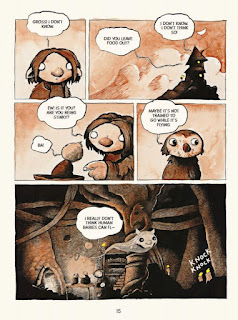
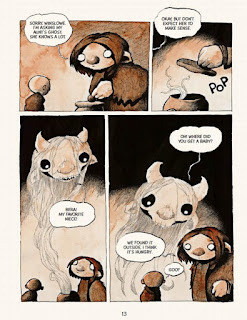
Bera, Winslowe and the baby in the cauldron are let down, betrayed and half-helped by one troll after another (one with two heads and one with three, just so you know there is a reason why Bera is referred to as a one-headed troll.) The raft of monsters and dangers in Bera the One-Headed Troll are wonderfully, gently menacing and Bera faces them all with quiet determination, much like Nanna the Great, an ancient troll legend who is happily turning into a hill. The climax of Bera the One Headed Troll, and the ending, are great, but honestly, I was happy trailing behind Bera, Winslowe and the baby as they wandered the forest throughout the night. I would love to see this trio again, but until then I'm getting my hands on a copy of Maddy Kettle!
Source: Review Copy
Compass South is the fantastic first adventure in the Four Points series of graphic novels written by Hope Larson and illustrated by Rebecca Mock. As I finished reading this book, I felt like I had read a complete novel, there are so many details, world building and character diveristy in this book. In fact, I was reminded of S.E. Grove's trilogy that begins with The Glass Sentence, although Larson's book is set firmly - so far - in real, not an alternative, historical landscape. Mock's illustrations, which are filled with warm earth tones, packed with movement and energy. At times, I had to remind myself of which twin was which, but, in all fairness, this is a story with two sets of redheaded twins!

Set in 1860, Compass South begins with a prologue that explains how and why twins Alexander and Cleopatra Dodge made it from Ireland to New York City with two very special items - a compass and a pocket knife. Twelve years later, the only father they have ever known (but not their birth father) has disappeared and the twins have joined the Black Hook gang, stealing to survive. When Alexander gets caught, he and Cleopatra make a deal that sends them to New Orleans with Luther, a higher up in the Black Hook gang, close on their trail. Luther has been recruited by Felix Worley, also known as Lucky Worley, captain of the black ship, El Caleuche, to find the twins and relieve them of their heirlooms.

These threads alone are enough to keep Compass South moving at a fast pace, but Larson weaves in a few more threads that make the story even richer. Before boarding the train to New Orleans, Alexander sees an add offering a reward for the return of redheaded twins to their father, who went West to find his fortune five years earlier. Alex convinces Cleo to cut her hair so they can pose as Samuel and Jeremiah Kimball and make their way to San Francisco to collect the reward and find their father. Of course things don't go as planned, starting with a run in with red headed twin boys that lands Alex and Edwin back in jail and Cleo and Silas without a plan.
While it's a challenge at times to remember which twin is which, especially after Cleo cuts her hair, the hot head Alex is paired with Silas, who has a mysterious ailment that leaves him weak, while thoughtful Cleo ends up with Edwin, who shares Alex's temperament. I will tell you that the twin pairs both end up on ships, but what happens to them, where they end up and what Luther and Worley want with them, well, you'll just have to read to find out!
Source: Purchased
Compass South is the fantastic first adventure in the Four Points series of graphic novels written by Hope Larson and illustrated by Rebecca Mock. As I finished reading this book, I felt like I had read a complete novel, there are so many details, world building and character diveristy in this book. In fact, I was reminded of S.E. Grove's trilogy that begins with The Glass Sentence, although Larson's book is set firmly - so far - in real, not an alternative, historical landscape. Mock's illustrations, which are filled with warm earth tones, packed with movement and energy. At times, I had to remind myself of which twin was which, but, in all fairness, this is a story with two sets of redheaded twins!

Set in 1860, Compass South begins with a prologue that explains how and why twins Alexander and Cleopatra Dodge made it from Ireland to New York City with two very special items - a compass and a pocket knife. Twelve years later, the only father they have ever known (but not their birth father) has disappeared and the twins have joined the Black Hook gang, stealing to survive. When Alexander gets caught, he and Cleopatra make a deal that sends them to New Orleans with Luther, a higher up in the Black Hook gang, close on their trail. Luther has been recruited by Felix Worley, also known as Lucky Worley, captain of the black ship, El Caleuche, to find the twins and relieve them of their heirlooms.

These threads alone are enough to keep Compass South moving at a fast pace, but Larson weaves in a few more threads that make the story even richer. Before boarding the train to New Orleans, Alexander sees an add offering a reward for the return of redheaded twins to their father, who went West to find his fortune five years earlier. Alex convinces Cleo to cut her hair so they can pose as Samuel and Jeremiah Kimball and make their way to San Francisco to collect the reward and find their father. Of course things don't go as planned, starting with a run in with red headed twin boys that lands Alex and Edwin back in jail and Cleo and Silas without a plan.
While it's a challenge at times to remember which twin is which, especially after Cleo cuts her hair, the hot head Alex is paired with Silas, who has a mysterious ailment that leaves him weak, while thoughtful Cleo ends up with Edwin, who shares Alex's temperament. I will tell you that the twin pairs both end up on ships, but what happens to them, where they end up and what Luther and Worley want with them, well, you'll just have to read to find out!
Source: Purchased

By: Tanya,
on 8/19/2016
Blog:
Children's Book Reviews and Then Some
(
Login to Add to MyJacketFlap)
JacketFlap tags:
Graphic Novel,
summer,
TEEN,
Real Life Girl Stories,
Summer Stories,
Summer Camp Story,
TEEN: Graphic Novel,
auto/biography,
aauthor: Thrash,
Add a tag
Honor Girl is Maggie Thrash's graphic memoir that was released last year and garnered awards and attention. Thrash chronicles the summer at an all girls camp where, having just turned fifteen, she falls in love for the first time. 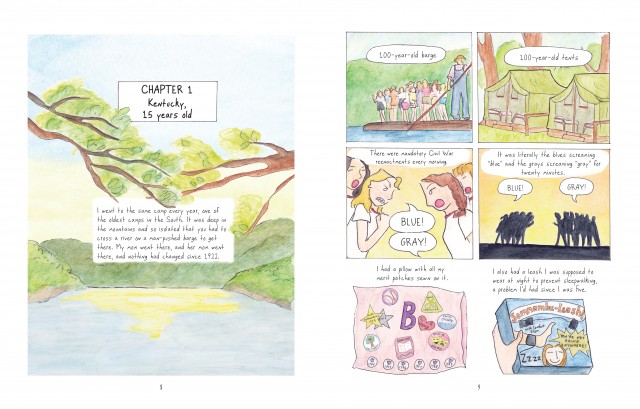
Maggie's mom and her grandma went to Camp Bellflower, set deep in the Kentucky Appalachians. Every summer, on the first night of camp, the Honor Girl, chosen on the last night of camp the summer before, is serenaded. At the end of the song, the Honor Girl's candle is used to light the candles of all the other campers. Thrash writes, "the criteria for Honor Girl were vague, with no particular definition. It was just the one who seemed, in an unmistakable way, to represent the best of us." Maggie is reading Harry Potter and the Goblet of Fire, her favorite Backstreet Boy is Kevin Richardson and she wears a leash at night that tethers her to her bed and keeps her from sleepwalking. The details of 15-year-old Maggie's life are mundane yet so genuinely real. Thrash is a gifted writer, making the quiet, everyday minutiae interesting and engaging. It's easy to get inside Maggie's head, feel what she feels, be fifteen.

Thrash tells the story of her first crush in all its thwarted, unconsummated, painful truth and it happens the way that I am sure most first loves happen, not the way they play out in fiction, especially YA fiction. Her crush, Erin, a 19-year-old counselor and astronomy major at college in Colorado, is not unknown to Maggie. But, she begins to feel differently about Erin after she gives her a routine lice check, running her fingers through Maggie's hair. Thrash uses wordless panels to illustrate this seen and as you scan you can feel something turning on, waking up, or beginning to slowly burn inside of Maggie. Thrash's skill as a visual story teller deepens the story immensely. Her illustration style is markedly different and less polished than many other graphic novels I have read. I'm still learning how to write about the art work in graphic novels and often look to other reviewers to help me shape my thoughts. I turned to Monica Johnson's review for The Comics Journal and found that her words describe Thrash's style (and the unique abilities that graphic novels have over other forms of writing) better than any I could find. Of Honor Girl Johnson writes,
Thrash certainly has drawing skills, but they're her own, and they're specifically savvy for the story she is telling. Her bare-bones line drawings colored with watercolor pencils seem to be channeled directly from her 15-year-old self. The drawings have the rawness and bright-eyed directness of the teenager depicted in them, who can't hide behind a catalog of romantic experience and mastery. This is part of the brilliance of the comic medium itself - the way images work in concert with the literal to tell a deeper, much richer story - and Thrash really hits the mark with it. The drawings are so believably vulnerable, which is maybe why her story feels so devastating.
Johnson's use of the word vulnerable is well placed, both in describing the illustrations, Maggie and Erin. Maggie and Erin have moments of vulnerability and missed opportunities. Erin is a counselor for the junior girls and Maggie is a senior girl, so they don't have many chances to run into each other alone. Then there is the fact that, in the eyes of the law, Erin is an adult and Maggie is a child, not to mention that, even though it's 2000, this is the South and a Christian girl's camp and being openly gay is not accepted. Maggie shares her feelings about Erin with friends and finds sympathy and support. They keep Maggie's secret and also nudge - or shove, in the way that teenage girls do - her toward Erin. In a meeting alone between Erin and Maggie, Maggie knows that Erin has made a move, and now it's up to her to make the kiss happen. But, filled with self doubt, she can't make it happen. She can't be that vulnerable.

While Honor Girl is a memoir about first love, it is also, if peripherally about being gay. Maggie is pulled aside by the head counselor who starts wide, telling her that her parents could sue the camp for statutory rape if her relationship with Erin goes any farther. Circling in for her target, she tells Maggie that it's, "her job to make sure everyone feels safe" because camp is a place where "girls can be totally innocent and free, maybe for the last time in their lives." Maggie assures her that she does feel safe, to which the response is, "Everyone else needs to feel safe, too. From you. . . Don't ruin it for everyone." The brutality of that moment is hard to read, especially because I think most of us, most women, experienced a time in our adolescence when an adult betrayed, disappointed or backhandedly told us not to be ourselves and those words go deep.
Thrash bookends Honor Girl with an event that takes place two years after her summer with Erin, but seems to play itself out the same as it did at Camp Bellflower. As Johnson says wisely in her review, "If you don't let people know that they are wanted, they will go away. Love relationships are fragile opportunities. They need care and attention. They need those moments to happen." Honor Girl is a powerful, bittersweet reminder of this.
Source: Review Copy
 Last year I read and loved, as I do any book that makes food and cooking a central plot thread, Rutabaga the Adventure Chef #1 by Eric Colossal. Rutabaga, his pop-up kitchen and Pot, his trusty cauldron/pet, are back for more food, fun and adventure in Rutabaga the Adventure Chef: Feasts of Fury. And, as before, Rutabaga is a little bit goofy, a little bit gullible and a very passionate about cooking and feeding his friends, and even his enemies, from time to time.
Last year I read and loved, as I do any book that makes food and cooking a central plot thread, Rutabaga the Adventure Chef #1 by Eric Colossal. Rutabaga, his pop-up kitchen and Pot, his trusty cauldron/pet, are back for more food, fun and adventure in Rutabaga the Adventure Chef: Feasts of Fury. And, as before, Rutabaga is a little bit goofy, a little bit gullible and a very passionate about cooking and feeding his friends, and even his enemies, from time to time.
Rutabaga the Adventure Chef: Feasts of Fury finds Rutabaga and Pot in the land of the dreaded gubblins where he meets, and cooks for, an old timer who shares memories of a soup he ate more than 30 years ago, prepared - with a special, secret ingredient - by his uncle. But, as he leads Rutabaga to the spot where he thought his uncle found the secret ingredient, a big, fanged surprise is waiting for him.


From there, Rutabaga meets a troupe of actors and inspires a new play with an old favorite from his cooking school days, Poisoned Pot Pie. The pie isn't really poisoned, but there is a bean hidden in one of the individual pies and the person who gets it has to wash up. Rutabaga meets a mysterious thief/princess/liar named Minus and a very cool ingredient is part of a fantastic recipe that involves lock picking. When those dreaded gubblins do finally materialize, I think you can guess how Rutabaga gets himself, Pot and Minus out of a very dire predicament. And, quite happily, as with book 1, Colossal shares a handful of Rutabaga's special recipes - that kids can really make - at the end of the book. There are Popping Chocolate Spiders, Gubblin Snot, No-Bake "Poisoned" Cookies!
Source: Review Copy
 In 2014 I reviewed the stand out graphic novel Lowriders in Space written by author, artist and librarian Cathy Camper and illustrated by Raúl the Third. I didn't think it was possible, but I love the follow up, Lowriders to the Center of the Earth, even more than the first book! While the ingenuity of the characters, the cars, and of course, space travel were big draws in the first book, the second book manages to pack in even more fantastic features that I know the students in my school will love. Camper ups the usage of Spanish vocabulary in Lowriders to the Center of the Earth, including a coyote who puns in Spanish, and weaves characters and themes from Atzec mythology and Mexican folklore into this fast paced, action packed graphic novel with even more of the intensely detailed, superb illustrations by Raúl the Third.
In 2014 I reviewed the stand out graphic novel Lowriders in Space written by author, artist and librarian Cathy Camper and illustrated by Raúl the Third. I didn't think it was possible, but I love the follow up, Lowriders to the Center of the Earth, even more than the first book! While the ingenuity of the characters, the cars, and of course, space travel were big draws in the first book, the second book manages to pack in even more fantastic features that I know the students in my school will love. Camper ups the usage of Spanish vocabulary in Lowriders to the Center of the Earth, including a coyote who puns in Spanish, and weaves characters and themes from Atzec mythology and Mexican folklore into this fast paced, action packed graphic novel with even more of the intensely detailed, superb illustrations by Raúl the Third.

Lowriders to the Center of the Earth starts with Lupe, a master mechanic and "an impala extraordinaire," Flappy, an octopus who wears a deer stalker and often travels in a jumbo popcorn bucket, and Elirio, painter of cars who has a "beak that was as steady as a surgeon's hand, his skill in detailing cars unparalleled, heading out to find Genie, their beloved missing cat. Footprints lead them out of town and into a giant cornfield where their odyssey beings.

It seems that Mictlantecuhtli, which I know is pronounced mick-lan-te-COOT-lee, thanks to the "What Does it Mean / ¿Que Significa?" back matter which also includes definitions of the geological terms used in the text, (but do know that these translations also appear in the story itself, at the bottom of the page) has taken Genie to his raucous underworld lair, which can be reached by way of a volcano. Straightaway, they hear a crying, wailing sound and discover a beautiful, blue weeping cat woman looking for her babies. La Lllorona takes a liking to Flappy and, while her crying can be a bit much, she does prove good to have along for the ride.
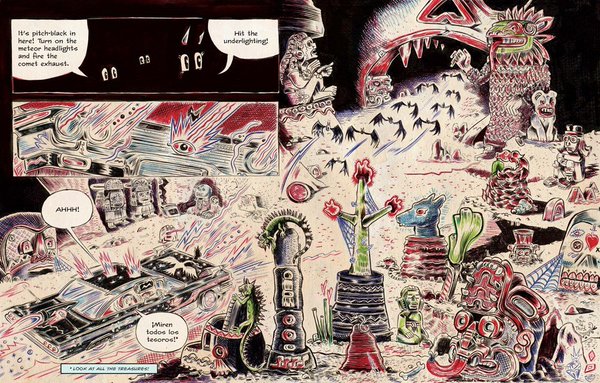
The gang have to face Mic's skeleton crew, the Wind of Knives, the challenge of transporting a bucket of water to the center of the earth and back and a wrestling match with lots of wrestling terms and a surprise from little Genie (spoiler!! their pet is really Tepeyollotl, the Aztec jaguar god who is Lord of the Animals) before they can reclaim their pet and return to the surface of the earth. There are so many more details in Lowriders to the Center of the Earth that I haven't even mentioned. I'll leave you with my favorite cameo appearance in the underworld comes when the gang pulls up to a torta shop where they see a familiar face. Perched behind the wheel of a monster truck with massive wheels, looking like a roadie for Mötley Crüe, his arm around a doe-eyed goat and a bottle of sangre de cabra in his hand is . . . the Chupacabra!
Source: Review Copy
 Lowriders to the Center of the Earth
Lowriders to the Center of the Earth
Written by Cathy Camper
Illustrated by Raúl the Third
They're back!
The impala - Lupe Impala, master mechanic
The mosquito - Elirio Malaria, the finest detail artist around
The octopus - El Chavo Flapjack Octopus, washcloth-wielding polisher of the Lowriders in Space Garage
If you think lowriders are impractical, think again. When the three amigos from the Lowriders in Space Garage go in search of their missing cat, their rocket-powered lowrider is just what they need. In this second book in the series, the three friends journey to the center of the earth and face off against a trickster coyote, an Aztec God, and other legendary Mexican and Aztec foes. As in the first book, they do it with humor, brains, and style—lowrider style—bajito and suavecito (low and slow).
Lowriders to the Center of the Earth is so visually cool, that it looks more like an older brother's indie comic book than a middle grade graphic novel. Raúl the Third uses red, black, and blue ink on sepia pages, and creates expressive faces, wild action, and hidden humor. The illustrations have a distinctly Mexican flair and invite the reader into the culture. His art is a perfect complement to Cathy Camper's hilarious wordplay. It's difficult to imagine that kids can learn Spanish, geology, ancient Aztec culture, Mexican culture, and the virtue of teamwork by reading a book that screams divertido (fun) but they can! Camper's dialogue is sharp and witty, and even features bilingual puns, as in this exchange between Lupe and the trickster coyote.
"Have you seen our cat?"
"Knock knock."
"Who's there?"
"Señor."
"Señor who?"
"Señor cat? I don't think so."
¡Ja, ja, ja!
This book may be even better than the first!
My copy of the book was provided by the publisher at my request when my LibraryThing copy went missing in the mail.


By: Tanya,
on 6/24/2016
Blog:
Children's Book Reviews and Then Some
(
Login to Add to MyJacketFlap)
JacketFlap tags:
Graphic Novel,
Nature,
Dinosaurs,
aauthor: Reed,
GNRL3,
aauthor: Wicks,
aauthor: Flood,
Science,
Reading Level 3,
Add a tag
The fantastic publisher FirstSecond, whose motto is precisely and perfectly, "Great graphic novels for every reader," started a new non-fiction series for kids this year. Science Comics: Get to Know Your Universe debuts with superb creators and subjects, Coral Reef: Cities in the Ocean by Maris Wicks and Dinosaurs: Fossils and Feathers by MK Reed and Joe Flood.

Wicks, author of the excellent non-fiction graphic novel for kids, Human Body Theater, worked as a part-time program educator at the New England Aquarium and just spent two months doing scientific outreach for Woods Hole Oceanographic Institution on board the R/V Atlantis! Her passion and knowledge shine through in Coral Reefs: Cities of the Ocean and her introduction is definitely worth reading, especially when she tells readers that we, "make choices that impact the environment with every dollar you spend, every action you take, and every vote that you cast," and encourages us to plant a milkweed, listing all the benefits of giving Monarch butterflies a food source and breeding habitat that can trickle down and benefit the dying coral reefs. With humor and an understanding for her audience, Wicks starts big with a first chapter titled, "What is Coral?" describing the classification system. Chapter Two, "How and Where Coral Reefs are Formed," where I learned that, despite the fact that coral reefs occupy about 1% of the earth's surface, cora reefs are home to more than 25% of all the animals found in the ocean! Chapter Three, "The Coral Reef Ecosystem Explored" takes a closer look at the 25% of the sea life living there and Chapter Four, "How are Coral Reefs Connected to the Rest of the Planet?" is the longest and possibly most important chapter in the book. From start to finish, Wicks makes Coral Reefs: Cities of the Ocean as vibrantly bright and compelling as a healthy coral reef with her popping palette and engaging writing style. A glossary, bibliography and additional resources included in the back matter. 

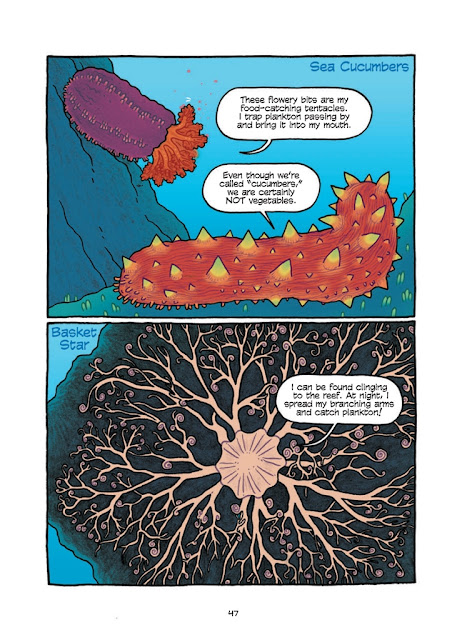

I have to, with great embarrassment, confess that, despite learning a fair bit about dinosaurs as each of my three children went through that phase of fascination, I tend to think of them as static. Dinosaurs: Fossils and Feathers, by MK Reed and Joe Flood, with an introduction by a dinosaur expert, changed my mind in a big way. In his introduction alone, Leonard Finkleman, Ph.D points out the many things that continue to be discovered about dinosaurs, as well as dinosaurs themselves, including the fact that once we didn't even know that dinosaurs lived on every continent. He goes on to write that Reed and Flood bring a "balance of science, philosophy, and history," to their book that is, "informative, funny, and, above all else, imaginative," noting that the lesson of Dinosaurs: Fossils and Feathers is that scientific discovery is very different from normal discovery. Finkleman writes, "Rather than limiting our imaginations, scientific discovery lets us imagine more about the world around us." With that in mind, Wicks and Flood follow paleontologists through history as they try to solve the greatest mystery of all, what happened to the dinosaurs?

Dinosaurs: Fossils and Feathers begins with a little time traveling, showing readers how ancient humans discovering dinosaur fossils thought they were anything from cyclopes to elephants to griffins. In the year 1800, these ideas changed radically when Mary Anning made remarkable finds on the Dorset coast, spending the next 35 years fossil hunting. They also detail the backhanded, sometimes dishonest machinations of the men who made these discoveries and pronouncements and delivered papers about these dinosaurs.

Joe Flood's illustrations are perfectly matched to the subject matter of Dinosaurs: Fossils and Feathers. While the illustrations of the dinosaurs are full of action and expression. The panels with humans present more of a challenge, because of the mostly Victorian time period and somewhat static nature of their roles int he story, yet Flood makes these compelling, especially through the expressions of the characters. There are notes, a glossary and further reading as well as two superb representations of the periods of the dinosaurs. Despite all this amazing information and illustrations, my favorite part of Dinosaurs: Fossils and Feathers comes at the end when the author and illustrator put themselves on the page an error in the text. There are 11 years between my oldest and youngest child. I learned that the big herbivore with the long neck was called the brontosaurus when my first child went through her dinosaur phase. By the time my youngest was going through his we learned that it was now reclassified as an Apatosaurus. On this page, Reed and Flood explain that, a few weeks before this book was due at the printer, researchers concluded that there was in fact enough difference between the two to make the Brontosaurus its own genus again, with a fact box noting that the Brontosaurus is now, "MK and Joe's least favorite dinosaur." With humor and knowledge, Dinosaurs: Fossils and Feathers proves that dinosaurs are anything but static.

Coming October, 2016 and February, 2017
Source: Review Copies
Red's Planet is the first in a comic book series from Eddie Pittman. Pittman, who says he taught himself to draw in the back of math class, has been a professional cartoonist, working in animation, comics and illustration for over 25 years. He has worked on films like Mulan, Tarzan, Fantasia 2000, Lilo & Stitch and The Emperor's New Groove and most recently the show Phineas & Ferb and the influence this work has on his graphic novel is delightfully evident, in both the bright color palette and cinematic sweep of his panels. And, Red's Planet is overflowing with visually fantastic, fascinating characters that I want to get to know better. At first glance, I feel like I can almost begin to guess their back stories. And, while Red's Planet is the first book in the series and almost entirely set up for the rest of the series, every panel of every page is engrossing and exciting. There will be many, many readers waiting for the second book, due out Spring 2017! 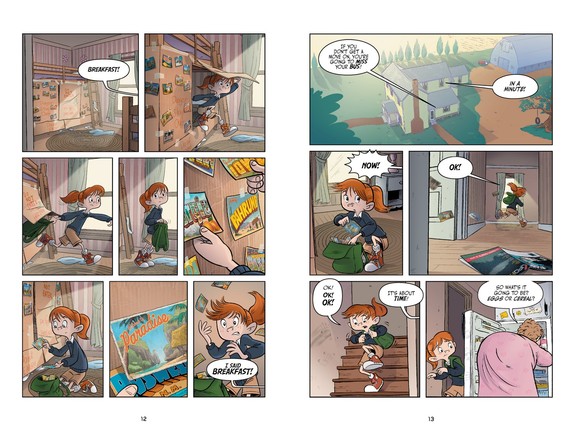
Red's Planet begins with a spooky UFO abduction in the dark of night on a country road. An old guy and his dog are zapped up into a triangular ship and never seen again. This story, "The Mysterious Zeke Hainey Incident," is being read out loud to a roomful of kids by another kid. We quickly learn that Red (we never learn her real name) is one of many foster children, headed down to breakfast and out the door to the bus. Red has intentionally worn non-regulation shoes and tells the kids she is headed home to change. Instead, she plays hooky and ends up in the backseat of a police car in big trouble. Instead of juvie, Red finds herself gone the route of Zeke Hainey.
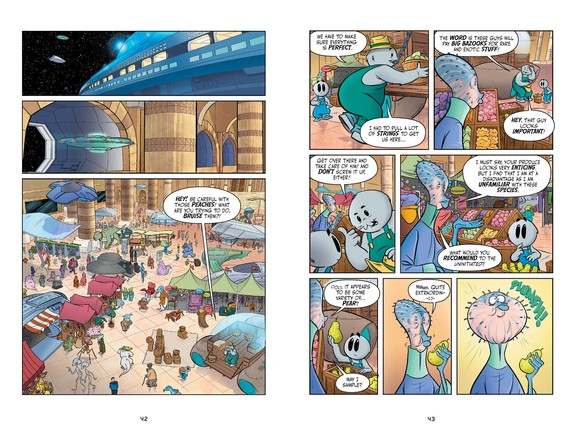
Like all good interplanetary stories, readers find themselves in a bustling marketplace. Here, the Aquilari, "ancients of Chelonia, collectors of time, the last sages of the wandering," and they are on a mission to collect rare items - and creatures. The police car with Red in it, as well as a few other things, make it onto the ship, but things are quickly going pear shaped again for Red as the Uskog pirates demand their treasure, which they believe is on the ship. As battle ensues, the ship veers off course and lands on a dusty planet that Red thinks looks like Texas. A multitude of aliens emerge and begin making sense of things, shunning Red left and right.

Red manages to befriend Tahee, a cute, big-eyed fuzzy guy who, when the ship took off, grabbed a strange glowing egg that he now carries everywhere with him. Red makes some dangerous foes but also a new friend in the crotchety Goose, a feline in a Hawaiian shirt who is sort of a forest ranger for the planet. With his grudging help, she and Tahee manage to get the rest of the aliens to safety, but first they get a glimpse at the amazing cargo that the Aquilari - and their robot boss who, after taking a rock to the head is a bit loopy - are collecting...
Source: Review Copy
Title: Secret Coders
Author: Gene Luen Yang
Illustrator: Mike Holmes
Publisher: First Second
Publication Date: September 29, 2015
ISBN-13: 978-1626720756
96 pp.
ARC provided by publisher via NetGalley
Secret Coders is exactly the kind of book I love to booktalk, especially when promoting Summer Reading Club. It has a mystery, it has a diverse cast, it has basketball, it has a friendship
Mysterious things are happening in Range, a small town in the shadow of Mount Rainier. Runoff Graphic Novel is a dramatic thriller which reminds me a…
The post RUNOFF Graphic Novel by Tom Manning Book Review appeared first on RABBLEBOY - The Official Blog of Kenneth Kit Lamug.
Faith Erin Hicks is the author and co-author of two of my favorite YA graphic novels, Friends with Boys and Nothing Can Possibly Go Wrong and now the superb first book in a trilogy, The Nameless City. The Nameless City has the feel of the animated series The Legend of Korra, the spinoff of Avatar: The Last Airbender, both of which I love, and both of which are and will soon be graphic novel series.
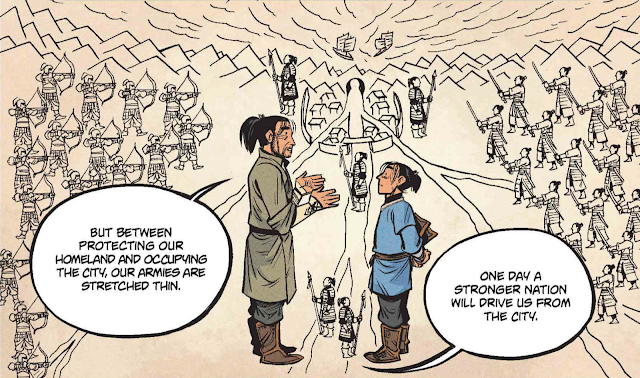
The world of The Nameless City is an ancient one with a vaguely Asian/Egyptian feel to it and her geography is brilliant. The Nameless City sits at the mouth of a great mountain pass where a massive arch has been carved out of the stone, allowing the the River of Lives to reach the sea. On one side of the pass are the Liao and Yisun nations, on the other, the Diao. Because of its location, the Nameless City is forever being invaded by one nation after another, who then changws the name. Eventually it comes to be called the Nameless City by everyone - except the natives, who are referred to as the Named.

Kaidu is from the Dao nation, one of many Dao children sent to the Nameless City to train to be part of military behind the safety of the palace walls. Once there, Kai meets his father, General Andren, for the first time. Andren takes Kai on a walk through the Nameless City, outside the safety of the palace walls, and Kai is clearly shaken by the poverty and homelessness he sees. But, it's also where he first sees Rat, a Named girl who has the remarkable skill of being able to fly across the tops of the tiled roofs of the city and perform a sort of ancient parkour.


Enemies at first, Kai and Rat forge a wary friendship that I think will lead to great changes for all over the course of the trilogy. There are themes of conquest and colonialism that make Rat and Kai's friendship all the more fascinating. The Nameless City, while a long and rich graphic novel, also leaves you feeling like you are just getting to know this ancient place. I can't wait for the second book in the series, The Stone Heart, which, in an interview with the L. A. Times, Hicks promises will be bonkers!
Also by Faith Erin Hicks!
Nothing Can Possibly Go Wrong Source: Review Copy
Everybody wants to rule the world.
The gorgeously rich illustrations, magic filled setting and wordless story of The Only Child by Guojing reminded me immediately of The Arrival by Shaun Tan. While Tan's book always feels deeply rooted in our world and the immigrant experience, despite the magical creatures and moments, Guojing's book beings in a foreign but familiar feeling city then flies off to a magic filled world of wonderful creatures and billowy clouds.
The Only Child begins with an author's note that frames the story perfectly. Guojing writes of growing up in China in the 1980s under the one-child policy. Her graphic novel grew out of a childhood experience that was common for children her age, which she refers to as a "very lonely generation." Put on a bus to her grandmother's as a six year old, Guojing fell asleep and woke up lost, crying and walking as she tried to find her way home. The Only Child begins with a cheerfully rumpled little girl waking in the morning just as her mother is leaving for work. A series of panels show her entertaining herself for a while, then looking at pictures in her scrapbook. A picture of her grandmother inspires her and she gets dressed, combs her hair, leaves a note and packs a tiny purse before heading out into the snowy, industrial, crowded city.
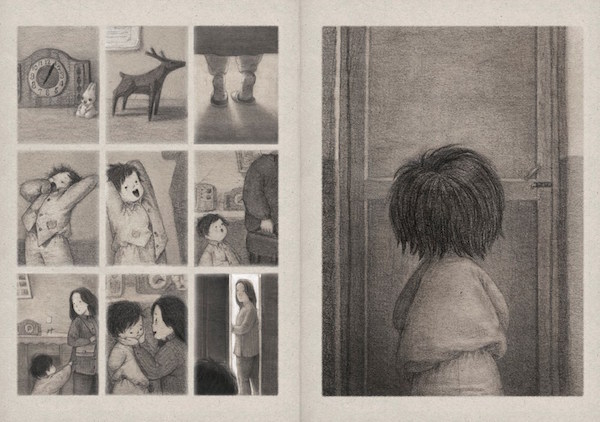
Guojing's illustrations of the city, the factories in the distance, the small houses, the tall apartment buildings, lumberyards, shops and the many electric bus lines are compelling, especially when viewed in the slightly grim sepia and grey tones of of the graphic novel.
The little girl falls asleep on the bus and wakes to a quiet, snowy forest. She begins to make her way through the forest, crying as she moves forward, until she sees a stag. Something about the beast encourages her to follow and soon she finds herself grabbing the horn of the stag and pulling herself onto its back. The two ascend a stairway of clouds to a pillowy land filled with play and exploration.

The pair find a new friend that looks a bit like a white otter crossed with a baby polar bear as well as an enormous, cloud surfing whale. These scenes create a quiet, ethereal world that is easy to sink into as you explore page after page, sunk in the atmosphere. It's even more amazing when you consider the limited palette that Guojing uses to evoke this blissful time. While fear, sadness and loneliness are part of the story, they feel far away for most of it. And the girl's return to her parents is, or course, a joyous one.
Describing it here, The Only Child sounds like a simple story, and in many ways it is. The unforgettable beauty of Guojing's book is everything she creates within the bounds of this simple story - the feelings she evokes, the memories, the warmth and the connection are anything but simple.
I love it when I find a graphic novel that is as enjoyable as any by Raina Telgemeier, and Awkward by Svetlana Chmakova is right up there, along with Newbery Honor winner Roller Girl by Victoria Jamieson. Chmakova's illustration style is reminiscent of Japanese manga - her characters have exaggerated expressions that add to the humor and emotions of the story. And her color palette is pale yellows, pinks and blues with occasional pops of darker colors. The plot of Awkward shows good kids making bad choices and working hard to making things right. Above all else, the kids in Awkward are creators - they make, they build, they draw. Chmakova ends her wonderful story with these words, "Cardinal Rule #3 for Surviving School: Build. Build things. Build Friendships. Build yourself. Bit by little bit. It may feel like you're not adding that much . . . but in the end, it will add up to a lot."
But, before we get to those wise words, we need to go back about 200 pages to the beginning. Penelope Torres, known as Peppi, is new at Berrybrook Middle School. Not only does she suffer the humiliation of of tripping in the busy hallway and spilling all her books on her first day, overloaded and embarrassed, she makes a bad choice. Peppi's Cardinal Rule #1 for surviving school, "Don't get noticed by the mean kids."
When a friendly student stops to help Peppi, the mean kids start making fun of both of them and Peppi does the unthinkable. Without thinking, she pushes the nice kid and runs off, then regrets it almost every minute of every day afterward.
Struggling in science class, but happily making new friends in art class, Peppi gets caught up in school club drama. The art club and the science club have to compete for the last table at the Club Fair. In the middle of all this, Peppi finds herself trying to apologize to Jamie, the nice kid she pushed, who just happens to be in the Science Club.
Chmakova layers lots of great details and characters into Awkward. There is Maribella, the president of the Art Club, who listens to Peppi's ideas but makes a few bad choices of her own that leave Peppi in a tough spot. There is a great field trip scene at the Natural History Museum and a thread that involves geocaching. And, of course, there are the art and science projects and the teachers who lead these clubs - the harried, paper wasting art teacher, Mr. Ramirez and the super-cool science teacher, Miss Tobins. Best of all, Awkward is not a quick read, which means that you have more time to savor it before starting it all over again.
Source: Purchased Copy
View Next 25 Posts
 Jeffrey Brown is the author of the first three fantastic Jedi Academy books, as well as many other hilarious books in which Darth Vader copes with hand-son fatherhood. Now, following another passion of his, he has created a graphic novel series Lucy & Andy Neanderthal, featuring siblings, Lucy and Andy, their clan, and some prehistoric creatures.
Jeffrey Brown is the author of the first three fantastic Jedi Academy books, as well as many other hilarious books in which Darth Vader copes with hand-son fatherhood. Now, following another passion of his, he has created a graphic novel series Lucy & Andy Neanderthal, featuring siblings, Lucy and Andy, their clan, and some prehistoric creatures. If you have read any of Brown's other books, then you know he is fantastic when it comes to creating engaging characters. Although I came of age with it, I'm not a fan of Star Wars, yet I found Brown's Jedi Academy books completely enthralling precisely because of the characters he populated this world with. In Lucy & Andy Neanderthal, we meet the tween siblings, their parents, Mr. and Mrs. Luba, and their baby brother Danny. Margaret and Phil, teens who are part of the clan, and the creaky old Mr. Daryl. As the older sister, Lucy can seem like a know-it-all, at least to Andy. In a funny twist, Brown gives Lucy some insights beyond her era, causing the other kids to think she's weird.
If you have read any of Brown's other books, then you know he is fantastic when it comes to creating engaging characters. Although I came of age with it, I'm not a fan of Star Wars, yet I found Brown's Jedi Academy books completely enthralling precisely because of the characters he populated this world with. In Lucy & Andy Neanderthal, we meet the tween siblings, their parents, Mr. and Mrs. Luba, and their baby brother Danny. Margaret and Phil, teens who are part of the clan, and the creaky old Mr. Daryl. As the older sister, Lucy can seem like a know-it-all, at least to Andy. In a funny twist, Brown gives Lucy some insights beyond her era, causing the other kids to think she's weird.
 Snow flees to Hooverville where she is rescued by a gang of orphaned boys living on the street. Their relationship is one of my favorite parts of Snow White, with the tough urchins refusing to tell Snow their names, until a tender, heartbrreaking moment later in the tale. I don't want to give away all of Phelan's marvelous adaptations, but I will say that the store window of Macy's does play a special role in this story. Phelan's expressive, suggestive illustrations save the sharp lines for the wicked stepmother's Louise Brook's bob, glaring eyes and her fitting end. Snow and the boys are soft lines and smiles when the world is treating them well, and the ending to Snow White treats them very well and just might bring a tear to your eye. Phelan uses splashes of red sparingly, eloquently and effectively in Snow White, with most of the story playing out in slate greys and occasional icy blues. However, Phelan's "happily ever after" is presented in a warm palette that is indeed a happy ending.
Snow flees to Hooverville where she is rescued by a gang of orphaned boys living on the street. Their relationship is one of my favorite parts of Snow White, with the tough urchins refusing to tell Snow their names, until a tender, heartbrreaking moment later in the tale. I don't want to give away all of Phelan's marvelous adaptations, but I will say that the store window of Macy's does play a special role in this story. Phelan's expressive, suggestive illustrations save the sharp lines for the wicked stepmother's Louise Brook's bob, glaring eyes and her fitting end. Snow and the boys are soft lines and smiles when the world is treating them well, and the ending to Snow White treats them very well and just might bring a tear to your eye. Phelan uses splashes of red sparingly, eloquently and effectively in Snow White, with most of the story playing out in slate greys and occasional icy blues. However, Phelan's "happily ever after" is presented in a warm palette that is indeed a happy ending.
 Cat tries to humor Maya and her excitement over meeting a ghost, but their expedition ultimately puts her in the hospital. Cat spends the rest of the novel coping with her guilt, making new friends, being angry at Carlos and worrying about Maya. Telgemeier ends Ghosts with the marvelous Halloween night, which flows into to the Día de los Muertos celebration where Cat has a change of heart that allows her to make connections with the abuela she never knew, forgive Carlos and make Maya's wish come true.
Cat tries to humor Maya and her excitement over meeting a ghost, but their expedition ultimately puts her in the hospital. Cat spends the rest of the novel coping with her guilt, making new friends, being angry at Carlos and worrying about Maya. Telgemeier ends Ghosts with the marvelous Halloween night, which flows into to the Día de los Muertos celebration where Cat has a change of heart that allows her to make connections with the abuela she never knew, forgive Carlos and make Maya's wish come true. Eric Orchard is the creator of Maddy Kettle, Book 1: The Adventure of the Thimblewitch in which eleven-year-old Maddy heads off on a quest after her bookstore-owning parents are turned into kangaroo rats by spider goblins. In Bera the One-Headed Troll, tables are turned as Bera, a troll, finds herself with a human infant she is trying to return to its parents. Bera's spare world is one of nighttime - if sunlight touches her, she will turn to stone - rendered in faded oranges and browns. And it is filled with ghosts, ogres with more than one head, benevolent rats, evil mermaids and hedgehog wizards that are a little creepy, a little goofy and entirely fascinating.
Eric Orchard is the creator of Maddy Kettle, Book 1: The Adventure of the Thimblewitch in which eleven-year-old Maddy heads off on a quest after her bookstore-owning parents are turned into kangaroo rats by spider goblins. In Bera the One-Headed Troll, tables are turned as Bera, a troll, finds herself with a human infant she is trying to return to its parents. Bera's spare world is one of nighttime - if sunlight touches her, she will turn to stone - rendered in faded oranges and browns. And it is filled with ghosts, ogres with more than one head, benevolent rats, evil mermaids and hedgehog wizards that are a little creepy, a little goofy and entirely fascinating. Last year I read and loved, as I do any book that makes food and cooking a central plot thread, Rutabaga the Adventure Chef #1 by Eric Colossal. Rutabaga, his pop-up kitchen and Pot, his trusty cauldron/pet, are back for more food, fun and adventure in Rutabaga the Adventure Chef: Feasts of Fury. And, as before, Rutabaga is a little bit goofy, a little bit gullible and a very passionate about cooking and feeding his friends, and even his enemies, from time to time.
Last year I read and loved, as I do any book that makes food and cooking a central plot thread, Rutabaga the Adventure Chef #1 by Eric Colossal. Rutabaga, his pop-up kitchen and Pot, his trusty cauldron/pet, are back for more food, fun and adventure in Rutabaga the Adventure Chef: Feasts of Fury. And, as before, Rutabaga is a little bit goofy, a little bit gullible and a very passionate about cooking and feeding his friends, and even his enemies, from time to time. In 2014 I reviewed the stand out graphic novel Lowriders in Space written by author, artist and librarian Cathy Camper and illustrated by Raúl the Third. I didn't think it was possible, but I love the follow up, Lowriders to the Center of the Earth, even more than the first book! While the ingenuity of the characters, the cars, and of course, space travel were big draws in the first book, the second book manages to pack in even more fantastic features that I know the students in my school will love. Camper ups the usage of Spanish vocabulary in Lowriders to the Center of the Earth, including a coyote who puns in Spanish, and weaves characters and themes from Atzec mythology and Mexican folklore into this fast paced, action packed graphic novel with even more of the intensely detailed, superb illustrations by Raúl the Third.
In 2014 I reviewed the stand out graphic novel Lowriders in Space written by author, artist and librarian Cathy Camper and illustrated by Raúl the Third. I didn't think it was possible, but I love the follow up, Lowriders to the Center of the Earth, even more than the first book! While the ingenuity of the characters, the cars, and of course, space travel were big draws in the first book, the second book manages to pack in even more fantastic features that I know the students in my school will love. Camper ups the usage of Spanish vocabulary in Lowriders to the Center of the Earth, including a coyote who puns in Spanish, and weaves characters and themes from Atzec mythology and Mexican folklore into this fast paced, action packed graphic novel with even more of the intensely detailed, superb illustrations by Raúl the Third. Lowriders to the Center of the Earth
Lowriders to the Center of the Earth
 Everybody wants to rule the world.
Everybody wants to rule the world.




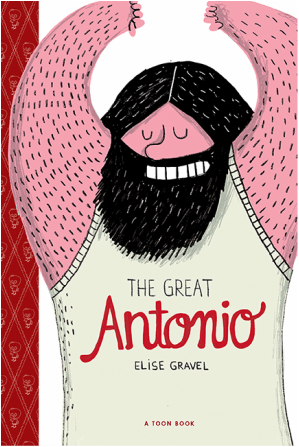



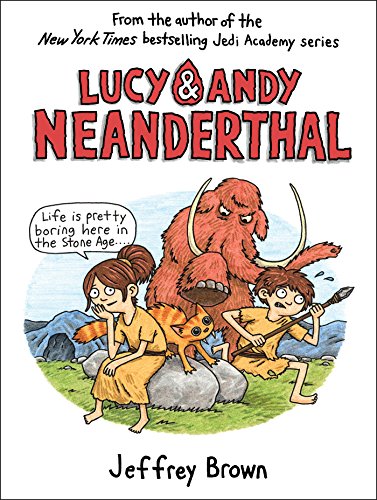

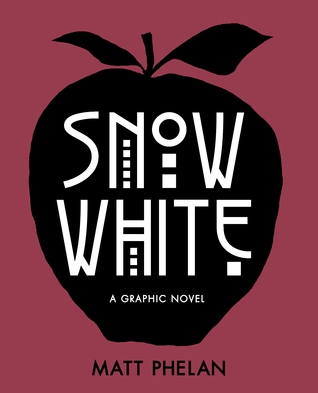


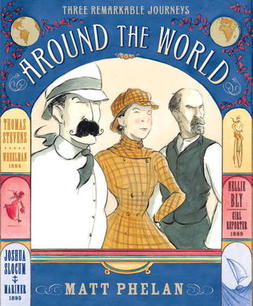
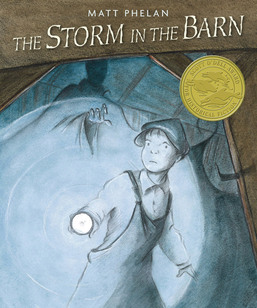
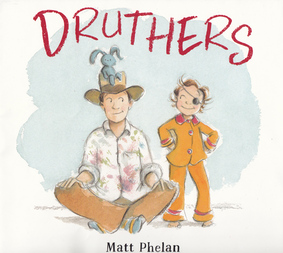











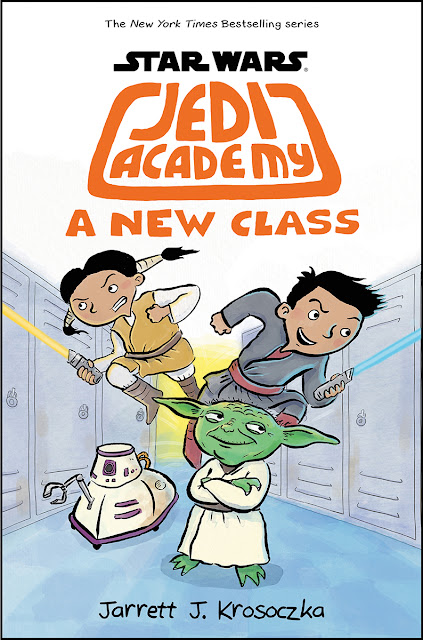





























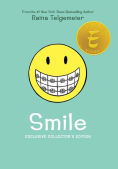

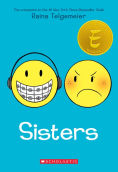

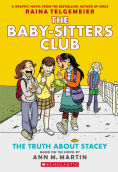


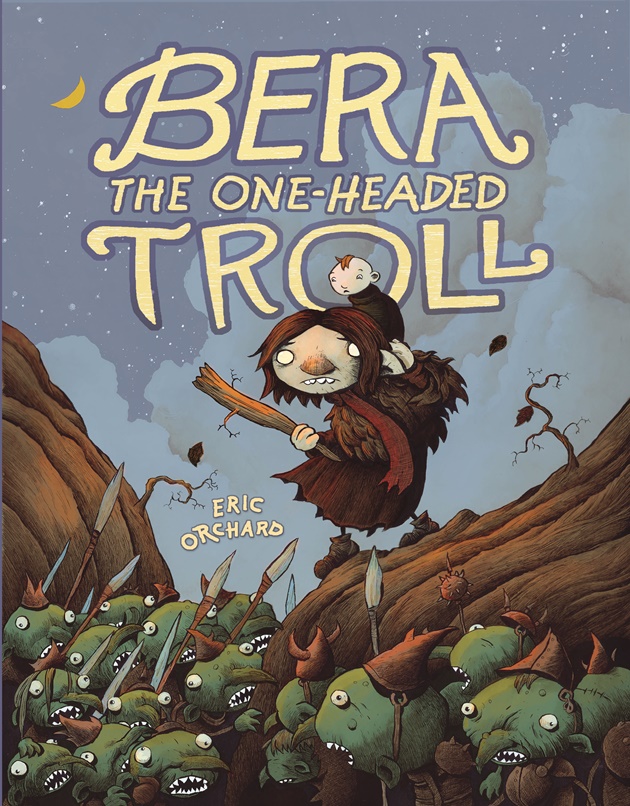




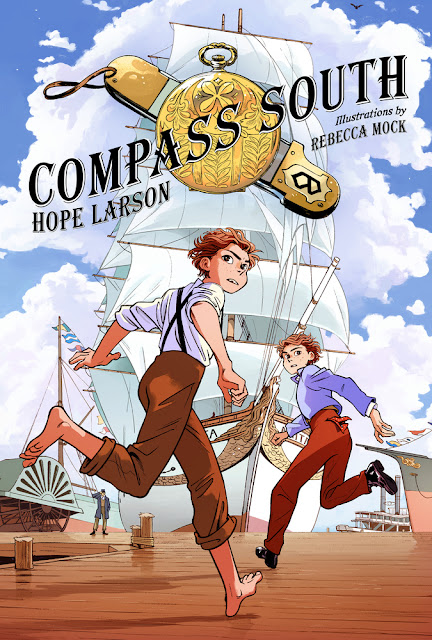







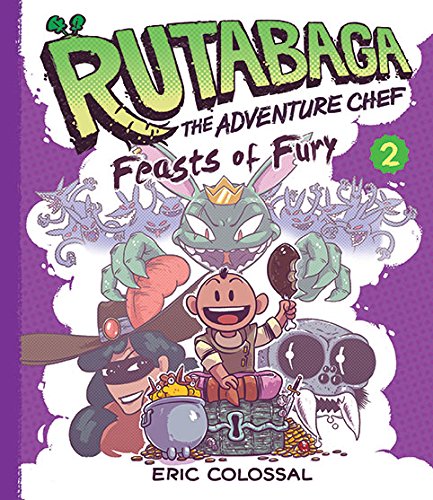



















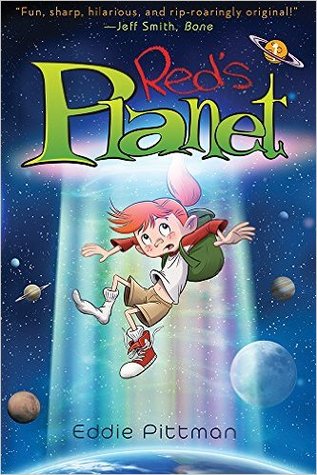












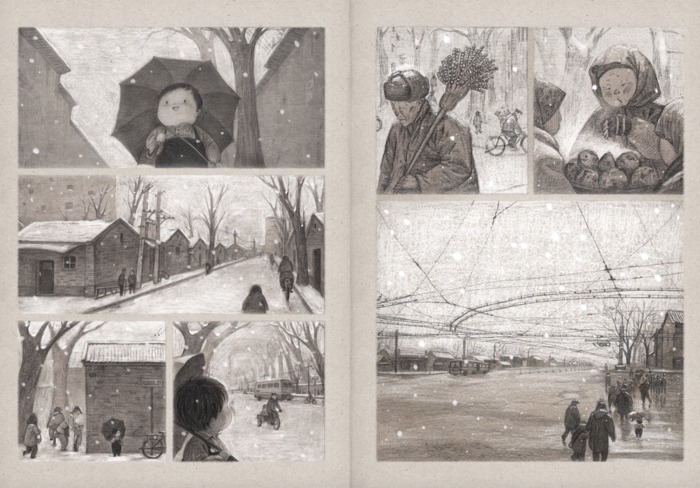
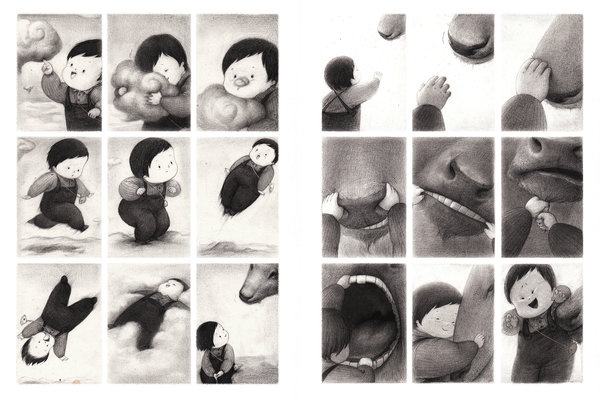
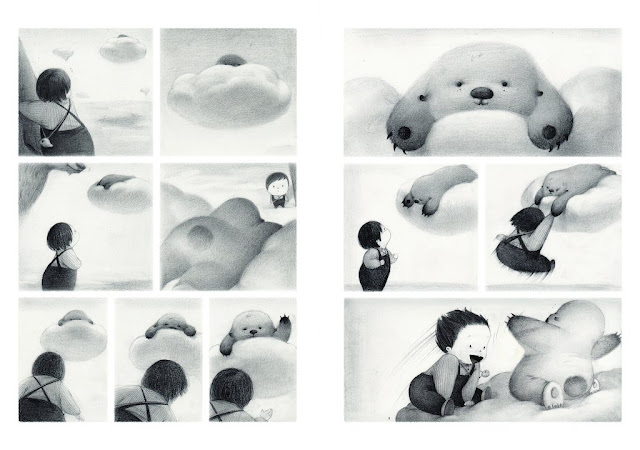
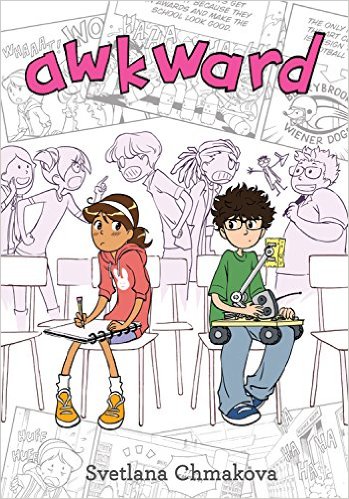




Such a fantastic series of graphic novels.
[…] wordless illustration. Other books in the LOVE series include LOVE: THE TIGER (available now) and LOVE: THE LION (available June […]